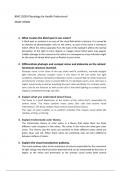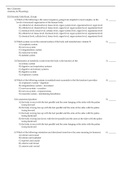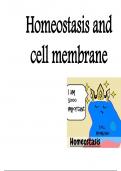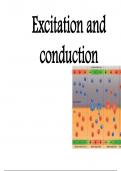Anatomy Physiology
California University Of Pennsylvania
All 7 results
Sort by

-
Red cell physiology notes
- Class notes • 64 pages • 2023
-
- $3.49
- + learn more
1. In macrophages, the globin part of Hb is broken down to individual amino acids (red arrow) and metabolized or used to build new proteins. 2. The heme of Hb releases iron. The heme is converted into bilirubin. 3. Blood transports iron to the red bone marrow, where it is used to produce new Hb (green arrows). 4. Blood transport bilirubin (blue arrows) to the liver. 5. Bilirubin is excreted as part of the bile into the small intestine. Some bilirubin derivatives contribute to the color of fa...

-
(PHYSIOLOGY) haemopoiesis
- Class notes • 33 pages • 2023
-
- $7.99
- + learn more
Haemopoiesis/Haematopoiesis occurs in the bone marrow from haematopoietic stem cell. Erythropoiesis Process of production of red cell Red cell’s lifespan is about 120 days Bone marrow replaces the cell lost by senescence, haemorrhage or destruction Red cell mass in normal man (26 – 29 mL/kg of body weight) maintained and regulated by the bone marrow
Auto “self” and nomos “control”. The responses of the body to the environment without conscious control of the individual. Carried out by the autonomic part of the nervous system.
Refers to the maintenance of constant internal the environment of the body. internal environment to the body = extracellular fluid (ECF) in which the cells live.
Electrical potential difference exists across the membrane of the cell with the inside being negative in relation to the outside.

-
Physiology (vision)
- Class notes • 2 pages • 2023
-
- $5.49
- + learn more
The trichromatic theory of color vision is a theory that states there are three different color receptors in the retina. The cones in the retina are what give color vision. This theory says the cones are sensitive to three different colors which are green, blue, and red. When these colors are combined, eyes can tell a difference between millions of colors.

-
TEST BANK Anatomy and Physiology I Final exam 2021/2022 Graded A+ 100% correct
- Exam (elaborations) • 10 pages • 2022
-
- $5.49
- + learn more
Question 1 Correct 1.00 points out of 1.00 Flag question Question text In an ecosystem, energy Select one: a. comes ultimately from bacteria b. cycles along with chemical nutrients c. typically flows from producers through a series of consumers d. typically flows from consumers to producers to decomposers Question 2 Correct 1.00 points out of 1.00 Flag question Question text Life is organized in a hierarchical fashion. Which of the following sequences correctly lists that hierarchy from least in...

Do you wonder why so many students wear nice clothes, have money to spare and enjoy tons of free time? Well, they sell on Stuvia! Imagine your study notes being downloaded a dozen times for $15 each. Every. Single. Day. Discover all about earning on Stuvia





